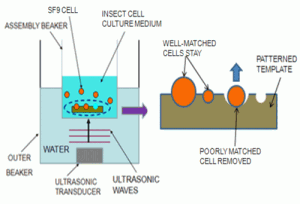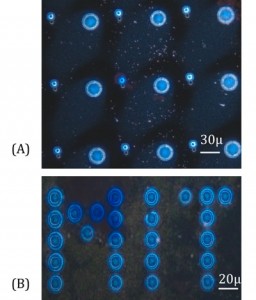Size-Selective Sorting of Cells using Templated Assembly by Selective Removal

Figure 1: Schematic illustration of the experimental set-up for TASR including the assembly fluid (in which variable chemistry and shape-matching are implemented through the choice of materials and component/template geometry) and the 1.7-MHz ultrasonic transducer that introduces mechanical forces to the selective removal system.
This work presents the size-selective sorting of single biological cells using Templated Assembly by Selective Removal (TASR). We have demonstrated the selective self-assembly of single SF9 cells (clonal isolate derived from Spodoptera frugiperda IPLB-Sf21-AE cells) into patterned hemispherical sites on rigid assembly templates using TASR. Experimental success with SF9 cells, which are nearly spherical and resistant to shear, suggests that self-assembly using TASR can also be extended to other cells and biological materials that are spherical. Examples include white blood cells and, in general, cells that maintain a well-defined morphology for short durations when dispersed in culture media, agitated mildly using megasonic excitation, and allowed to settle on a patterned substrate. Therefore, TASR-based biological self-assembly holds potential for several applications, such as cell-sorting for medical research or diagnostics, or isolation of single cells for studying their biological and mechanical behavior.

Figure 2: Optical micrograph of SF9 insect cells with mean diameter of 15 microns, stained with methylene blue and self-assembled (a) selectively into patterned hemispherical sites with alternating diameters of 12 and 22 microns (b) uniformly into patterned hemispherical sites with a diameter of 15 microns on a templated silicon surface using TASR.
In TASR, the system’s free energy is minimized when objects assemble in holes that match their shapes and sizes on the template’s surface (Figure 1). A combination of chemical and mechanical effects selectively removes objects from poorly matched holes. Previous work on TASR has shown that microcomponents made from relatively rigid materials such as silica [1] [2] and deformable materials like polystyrene [3] can be assembled effectively on similarly rigid patterned templates using this technique. In an extension of the application of TASR to biological systems, SF9 cells (which come in a range of sizes with a mean diameter of 15 microns) were successfully assembled using TASR onto patterned silicon templates. The assembly sites comprised holes with nearly hemispherical profiles etched in a silicon substrate using DRIE. Figure 2 shows optical micrographs of the assembly and demonstrates the size-selectivity of the process as well as the high yield of cell assembly using this technique.
References
- S. Jung and C. Livermore, “Achieving selective assembly with template topography and ultrasonically induced fluid forces,” Nanoletters, vol. 5, no. 11, pp. 2188-94, 2005. [↩]
- F. Eid, S. Jung, and C. Livermore, “Templated assembly by selective removal : simultaneous, selective assembly and model verification,” Nanotechnology vol. 19 p. 285602, 2008. [↩]
- G. Agarwal, A. Servi, F. Eid, and C. Livermore, “Shape Selective Assembly in Deformable Systems using Templated Assembly by Selective Removal,” Proc. of the Foundations of Nanoscience Conference- Self-Assembled Architectures and Devices, Snowbird, Utah, 2009. [↩]